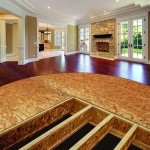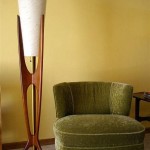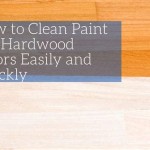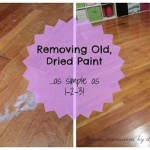How To Remove Scratches From Wooden Floors
Wooden floors, while adding warmth and character to a space, are susceptible to scratches. These marks can range from minor surface imperfections to deeper gouges that detract from the floor's overall aesthetic. Addressing these scratches promptly and effectively is crucial for maintaining the wood's integrity and preserving its visual appeal. This article will provide a comprehensive guide to removing scratches from wooden floors, covering various techniques based on the severity of the damage.
Before commencing any scratch removal process, accurately assessing the type of finish and the depth of the scratch is essential. Surface scratches primarily affect the finish layer, while deeper scratches penetrate the wood itself. Identifying the finish—whether it's polyurethane, varnish, wax, or oil—will determine the appropriate cleaning and repair methods. Failure to correctly identify the finish can result in further damage or an inconsistent appearance after the repair.
Gathering the necessary materials is also critical for a successful outcome. These materials often include fine-grit sandpaper (ranging from 120 to 400 grit), wood cleaner, microfiber cloths, wood filler (if necessary), stain pens or markers matching the floor's color, and appropriate finish materials compatible with the existing floor finish.
Addressing Minor Surface Scratches
Minor surface scratches are typically confined to the finish layer and do not penetrate the wood. These scratches often appear as light scuff marks and can usually be addressed with relatively simple techniques.
One of the first methods to try is using a specialized wood cleaner designed for hardwood floors. These cleaners are formulated to gently remove dirt and grime without damaging the finish. Apply the cleaner to a microfiber cloth and gently rub the affected area, following the wood grain. Avoid using excessive force or abrasive cleaners, as they can worsen the scratches.
For slightly more persistent scratches, a scratch concealer pen or wax stick, matched to the floor's color, can be used. These products fill in the scratch, making it less noticeable. Apply the concealer or wax according to the manufacturer's instructions, and then buff the area with a clean, soft cloth.
Another technique involves using a mild abrasive, such as a paste made from baking soda and water. Create a thick paste and apply it to the scratch, gently rubbing in the direction of the wood grain. After a few minutes, wipe away the paste with a damp cloth and dry the area thoroughly. This method can help to buff out very fine scratches but should be used cautiously to avoid damaging the finish.
Sometimes, a simple buffing with a fine steel wool (grade 0000) can alleviate minor scratches. Ensure the steel wool is clean and dry. Lightly buff the scratched area, moving with the grain of the wood. Avoid applying too much pressure. Afterward, thoroughly clean the area to remove any steel wool residue.
Repairing Deeper Scratches That Penetrate the Wood
Deeper scratches extend beyond the finish and into the wood itself. Repairing these scratches requires a more involved process that may include sanding, filling, and refinishing.
The first step in repairing a deep scratch is to clean the area thoroughly. Remove any dirt, debris, or loose finish around the scratch. This can be done with a wood cleaner and a clean cloth.
Next, carefully sand the scratched area. Start with a higher grit sandpaper (e.g., 120 grit) to remove the damaged wood and feather the edges of the scratch. Sand in the direction of the wood grain to avoid creating additional scratches. As the scratch becomes less visible, progressively use finer grit sandpaper (e.g., 220 grit, then 320 grit) to smooth the surface. The goal is to create a smooth, even surface that blends seamlessly with the surrounding wood. Avoid sanding beyond the immediate area of the scratch, as this can create an uneven appearance.
If the scratch is deep and wide, it may be necessary to fill it with wood filler. Choose a wood filler that is compatible with the type of wood and stain used on the floor. Apply the filler carefully, filling the scratch completely and slightly overfilling it. Allow the filler to dry completely according to the manufacturer's instructions.
Once the filler is dry, sand it smooth using fine-grit sandpaper (e.g., 320 or 400 grit) until it is flush with the surrounding wood surface. Again, sand in the direction of the wood grain to avoid creating new scratches.
After sanding, it's necessary to stain the filled area to match the color of the surrounding wood. Use a stain pen or marker that closely matches the floor's color. Apply the stain sparingly and blend it into the surrounding wood. Allow the stain to dry completely before proceeding.
Finally, apply a finish coat to the repaired area. Use a finish that is compatible with the existing floor finish (e.g., polyurethane, varnish, wax, or oil). Apply the finish evenly and allow it to dry completely according to the manufacturer's instructions. Multiple coats may be necessary to achieve a seamless appearance. Lightly sand between coats with very fine-grit sandpaper (e.g., 400 grit) for a smoother finish.
Practical Considerations and Precautions
Several practical considerations can improve the success of scratch removal efforts. Before undertaking a major repair, it's advisable to test the chosen method on an inconspicuous area of the floor to ensure color matching and compatibility of materials. This prevents unexpected results on more visible sections.
When sanding, use caution to avoid over-sanding, which can lead to unevenness or removal of the finish in surrounding areas. Consistent and even pressure is crucial for achieving a smooth, blended result. Dust created during sanding should be thoroughly removed using a vacuum cleaner with a brush attachment to prevent it from interfering with the finish application.
Selecting the correct stain color is vital for seamless integration of the repaired area. It may be necessary to mix stains to achieve a precise match. Apply stain in thin, even layers, allowing each layer to dry completely before adding another. This prevents blotching and ensures a uniform color. Consider using a pre-stain wood conditioner on wood filler to ensure even stain absorption.
Appropriate ventilation is essential when working with sanding, staining, and finishing products. Many of these products contain volatile organic compounds (VOCs) that can be harmful if inhaled. Ensure adequate airflow by opening windows and using fans. Also, wear appropriate personal protective equipment, such as gloves and a dust mask, to protect skin and respiratory system.
For extensive or complex scratch damage, professional hardwood floor refinishing services may be the most effective solution. Professionals have the expertise, equipment, and materials to restore the floor to its original condition, ensuring a uniform and durable finish.
Preventing future scratches is equally important. Use area rugs in high-traffic areas to protect the floor from wear and tear. Place felt pads under furniture legs to prevent scratches when moving furniture. Regularly sweep or vacuum the floor to remove dirt and debris that can cause scratches. Avoid wearing shoes with hard soles or heels on wooden floors. Regularly clean the floor with a wood cleaner designed for hardwood floors. Avoid using harsh chemicals or abrasive cleaners, as they can damage the finish.
Maintaining proper humidity levels in the home can also help to prevent scratches. Wood expands and contracts with changes in humidity, which can cause stress on the floor and make it more susceptible to scratches. Use a humidifier or dehumidifier to maintain humidity levels between 30% and 50%.
By understanding these methods and taking precautionary measures, it becomes possible to effectively address scratches on wooden floors, preserving their beauty and extending their lifespan.

How To Remove Scratches From Wood Floors Svb

3 Ways To Eliminate Scratches On Wood Floors Youtube

How To Fix Scratches On Laminate Flooring Directflooring Direct

3 Diy Way To Fix A Scratch In Hardwood Floors 5 Steps With Pictures Instructables

How To Get Scratches Out Of Wood Floors Tips For Engineered Solid Oak Flooring Blog

How To Repair Wood Floor Scratches Quick Fix Friday Polished Habitat

How To Fix Scratches On Hardwood Floors

The Easiest Hardwood Floor Scratch Repair Average But Inspired

How To Repair Wood Floor Scratches Quick Fix Friday Polished Habitat

9 Tips For Removing Scratches On Hardwood Flooring Cosmaroma







